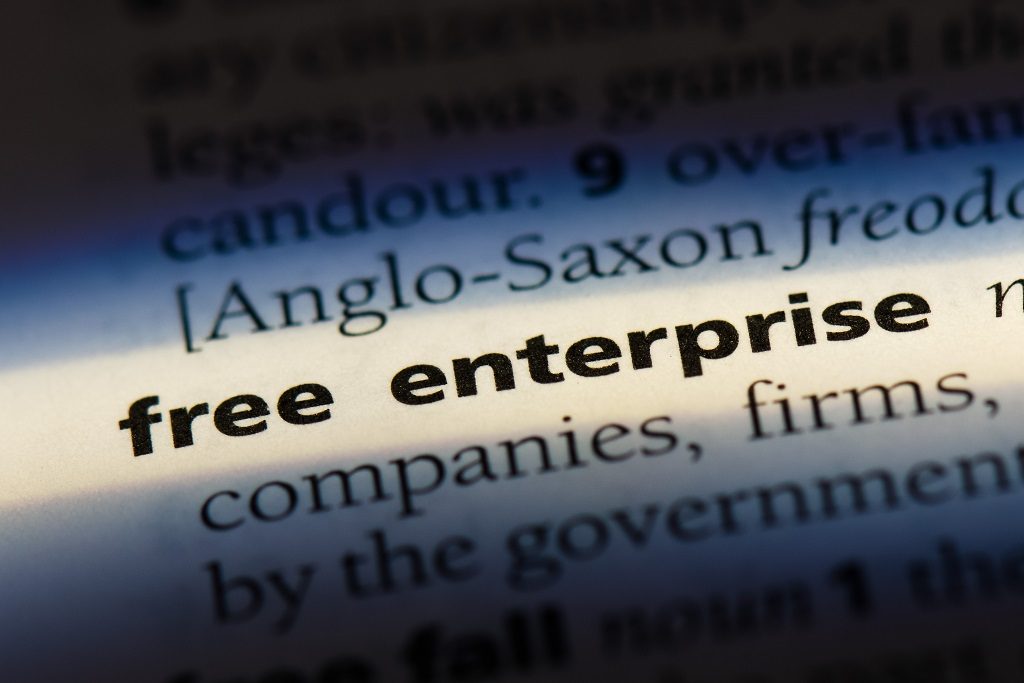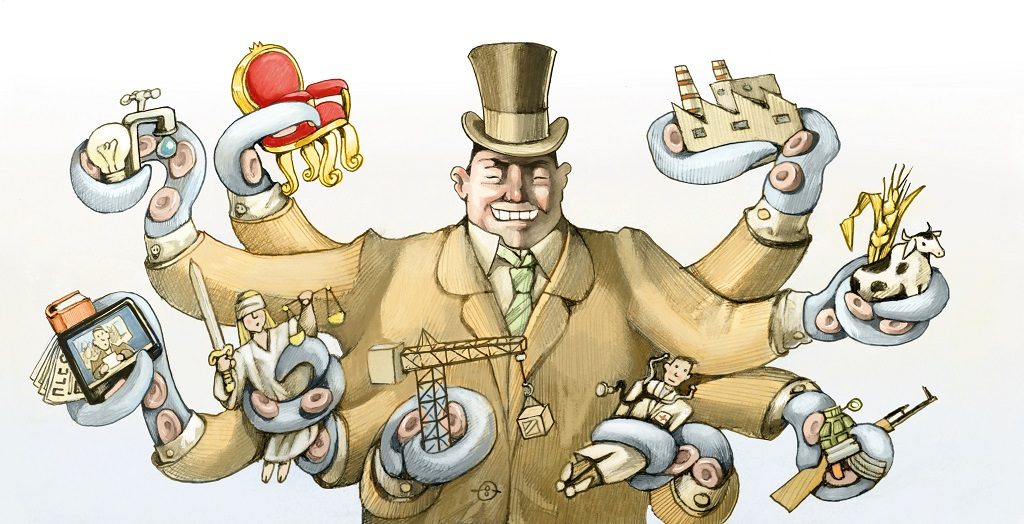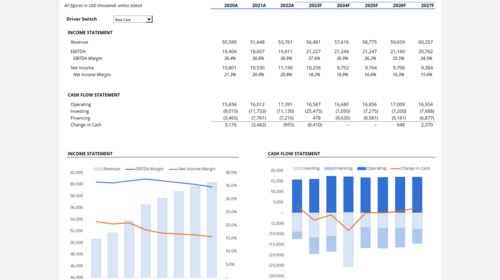- What Exactly is Free Enterprise?
- How Does a Free Enterprise System Work?
- What are the Characteristics of a Free Enterprise System?
- Is Free Enterprise the Same as Capitalism?
- Examples of Free Enterprise
- Does the United States have a Free Enterprise System?
- What are the Dangers of a Free Enterprise Economy?
Free Enterprise
A market-based economic system driven by market forces rather than by government interference
Free enterprise is an economic system where market forces determine prices, supply, and demand of goods and services without interference from the government.

Key Highlights
- Free enterprise refers to a market-based economic system driven by market forces rather than by government interference.
- Free enterprise is often confused with capitalism, which is not the same.
- While free enterprise has its benefits, it is not without its pitfalls.
What Exactly is Free Enterprise?
Free enterprise refers to a market-based economic system driven by market forces, rather than by government interference. Often referred to as a free market system, the private sector is given the economic freedom to make its own economic decisions on what to buy and sell, how much it wants to work or risk, and how it chooses to participate in businesses.
How Does a Free Enterprise System Work?
A free enterprise system follows the “laissez-faire” concept of economic freedom, where the optimal functioning of markets needs minimal government intervention.
Free enterprise is built upon four economic units, or components, each with its own role to play:
- Households: These units own most of the country’s economic resources and voluntarily decide how to use them—such as labor and consumption.
- Companies: These economic units are started by entrepreneurs, who look to innovate, compete, and organize resources of the households and turn that into economic profits.
- Markets: Markets act as agents, or brokers, to bring buyers and sellers together so they can exchange goods, services, resources, or money. Prices should be set with little government interference.
- Governments: Their role is to act as a protector and to define, maintain, and protect the rule of society—not to control supply and demand.
Free enterprise is based upon personal freedom. No one is forced to buy or sell anything they don’t want to. Both buyers and sellers are better off in a transaction—the seller can make a profit and the buyer can obtain a good or service that they want. This mutual benefit for companies and households is meant to drive entrepreneurialism.
Free markets benefit a society as households are able to express individual tastes and preferences, rather than have a central authority determine what is produced or consumed.
What are the Characteristics of a Free Enterprise System?
The American economics system of free enterprise has four basic principles:
- Freedom of choice: Buyers and sellers have the freedom of choosing with whom and at what price they transact.
- Private property rights: In a free enterprise system, the property rights of the individual or business are guaranteed.
- Profit motive: The goal of a free market system is to allow individuals and businesses to maximize profits, eliminating inefficiencies in the economy.
- Owner control: Sometimes referred to as voluntary exchange, an owner of an asset or good has the right to choose whether or not to exchange that asset or good and not be forced into a trade. Likewise, consumers should not be forced to purchase something they don’t want to buy.
Is Free Enterprise the Same as Capitalism?
No, capitalism and free enterprise are not the same. Free enterprise is an economic system based upon a free and open market for anyone who wants to fill a demand.
Capitalists pursue profit. They do this by deploying privately owned capital assets, such as factories and mines, and employing labor to earn profits for themselves.

Unlike free enterprise, capitalism can exist with controls and restrictions. For example, as far back as 1936, John Maynard Keynes argued that state intervention and capitalism can co-exist. In the extreme, capitalism can exist even when there are strict government controls, called state-guided capitalism, deciding which sectors of the economy are allowed to grow.
So, one could say that free enterprise allows for capitalism to exist, the opposite is not always true. Capitalism can and does thrive even without free enterprise or free markets.
Examples of Free Enterprise
Most countries have some form of free enterprise, but there are no economies that have a completely hands-off, free enterprise system.
A country may have restrictions to protect consumers, the environment, or domestic industries. The country also may control what can be freely imported into the country or what may be exported. Furthermore, it may also enact fiscal and monetary policies to control the pace of growth in the economy.
Therefore, most free enterprise economies have some level of government control. Generally speaking, there are three levels of free market economy:
- Liberal Market Economy (“LME”): A liberal market economy aims to function with the least amount of government interference with respect to regulations, prices, and wages. Countries such as Singapore, Switzerland, and Hong Kong are considered some of the most liberal, although the United States is often cited as a classic LME.
- Coordinated Market Economy (“CME”): While generally free enterprise economies, these countries also have formal institutions that regulate the market and coordinate the interaction between businesses and households, such as unions. Often cited examples of countries that are CMEs are Japan and Germany.
- Mixed-Market Economy (“MME”): This economic system combines the elements of a free market economy with elements of a planned economy. While most MMEs have a free enterprise market system, the government regulates the market or owns key industries. Cuba and China are commonly considered MMEs and are sometimes known as a “command economy.”
Does the United States have a Free Enterprise System?
There is a belief that the United States is a free enterprise economy, but that isn’t true. While it might have been true in the past, the United States is better described as a hybrid nowadays. While most industries in the US are dominated by private enterprises, they have certain levels of government intervention, such as subsidies and tariffs, as well as environmental and financial regulations that stifle competition.
According to The Heritage Foundation 2023 Index of Economic Freedom, the US ranks 25th in the world, far below countries such as Singapore, Switzerland, Ireland, and Taiwan.

The US fares much better in the Fraser Institute’s 2022 Economic Freedom of the World report, where it comes in at number seven.
What are the Dangers of a Free Enterprise Economy?
While in theory, a completely free enterprise economy where the government is not involved in competitive markets sounds alluring, it is also not without potential problems.
Lack of economic incentives
Without government intervention, a free market economy will attempt to maximize profits above all else. Without economic incentives, certain economic activity might not happen.
For example, the recent COVID-19 pandemic demonstrated that many countries did not have adequate drug manufacturing facilities domestically. As a result, governments have prioritized building these facilities within their borders to ensure supply for their citizens.
Misallocation of resources
In a true free enterprise system, there may be certain groups of consumers who may be underserved. For example, internet providers might not be willing to invest in infrastructure for remote parts of a country, where a small population might not warrant the expenditure.
Deficient regulation
Without government regulation, there might be an incentive for bad actors to cut corners or engage in dangerous behavior. The tainted milk powder scandal in China of 2008 is a prime example of how greed and lack of regulation endangered consumers.
Absence of government backstops
If governments were truly not allowed to interfere in a free enterprise system, they would also not be allowed to step in when there is a real systemic risk to the economy.
In 2009, when the European Sovereign Debt Crisis threatened to spiral out of control, other European nations and supranational organizations had to step in to bail them out. In a truly free enterprise system, this sort of government interference would not have happened, potentially causing a much larger crisis.
Learn More
Thank you for reading CFI’s guide to Free Enterprise. To keep learning and developing your knowledge base, please explore the additional relevant resources below:
Create a free account to unlock this Template
Access and download collection of free Templates to help power your productivity and performance.
Already have an account? Log in
Supercharge your skills with Premium Templates
Take your learning and productivity to the next level with our Premium Templates.
Upgrading to a paid membership gives you access to our extensive collection of plug-and-play Templates designed to power your performance—as well as CFI's full course catalog and accredited Certification Programs.
Already have a Self-Study or Full-Immersion membership? Log in
Access Exclusive Templates
Gain unlimited access to more than 250 productivity Templates, CFI's full course catalog and accredited Certification Programs, hundreds of resources, expert reviews and support, the chance to work with real-world finance and research tools, and more.
Already have a Full-Immersion membership? Log in





